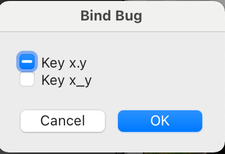LrView.bind (key) creates a non-working binding when "key" contains a period. To reproduce, install this plugin:
https://www.dropbox.com/s/fhx9521z9re47ro/bind-bug.lrdevplugin.2022.01.16.zip?dl=0
and then do File > Plug-in Extras > Bind Bug. That will produce this window:

The first checkbox should be unchecked (white), not in the mixed state (hyphen). Tested on LR 11.1 / Mac OS 11.6.2.
Just one more SDK bug to work around.
Here's the script for the Bind Bug command:
local LrBinding = import "LrBinding"
local LrDialogs = import "LrDialogs"
local LrFunctionContext = import "LrFunctionContext"
local LrView = import "LrView"
local bind = LrView.bind
local f = LrView.osFactory()
local key1 = "x.y"
local key2 = "x_y"
LrFunctionContext.callWithContext ("main", function (context)
local prop = LrBinding.makePropertyTable (context)
prop [key1], prop [key2] = false, false
assert (prop [key1] == false)
assert (prop [key2] == false)
LrDialogs.presentModalDialog {title = "Bind Bug",
contents = f:column {bind_to_object = prop,
f:checkbox {title = "Key " .. key1, value = bind (key1)},
f:checkbox {title = "Key " .. key2, value = bind (key2)}}}
end)